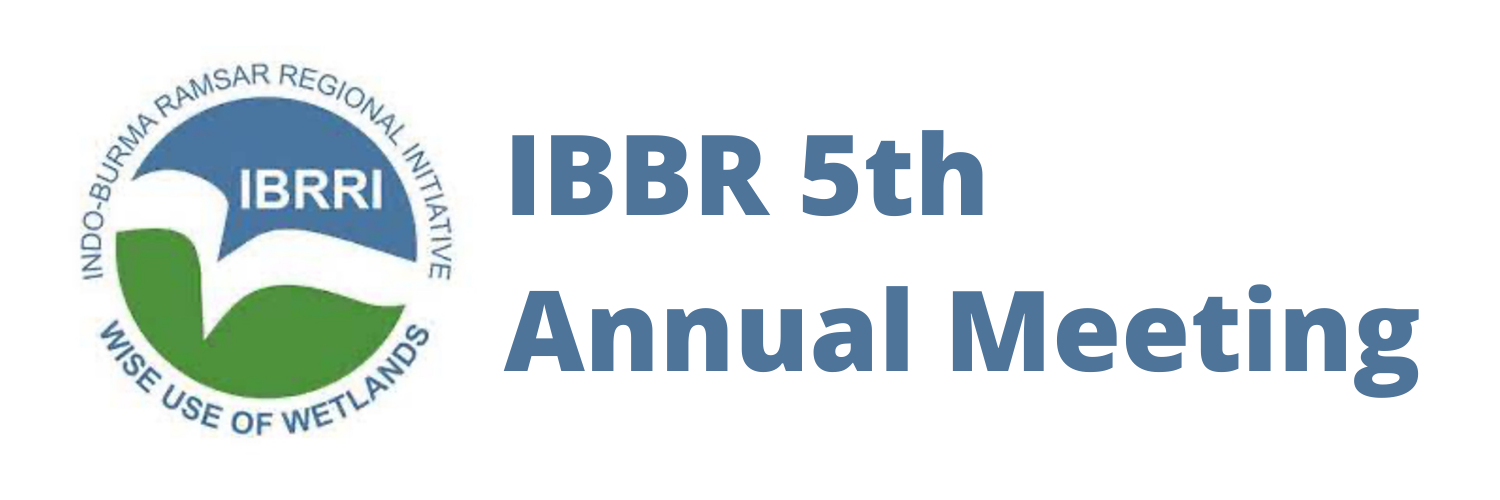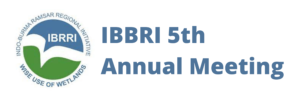
On 24 February, the EAAFP Secretariat virtually participated in the Fifth Annual Meeting of Indo-Burma Ramsar Regional Initiative (IBRRI), organized by IUCN Asia division as the IBRRI Secretariat. Representatives from IBBRI Secretariat, IUCN, five IBRRI member countries (Cambodia, Thailand, Myanmar, Laos, Vietnam), academia, and other RRIs, civil society organizations joined the meeting to discuss the last year outcomes and future opportunities. The meeting brought together stakeholders who work on Ramsar sites and other wetlands in the region, to report their work or progress in executing the Ramsar Strategic Plan, examine potential collaboration, share experiences, and present the work plans of 2022.
Mr. Sun Visal, on behalf of Dr. Srey Sunleang from Ministry of Environment of Cambodia, IBBRI Chair, opened the meeting with congratulatory remarks followed by the IBRRI Secretariat briefing on 2021 achievements and proposal of 2022 work plan. Regarding this year’s work plan, development, and publishment of IBRRI Wetlands Outlook were highlighted (EAAFP Secretariat partially sponsored). Its purpose is to collect comprehensive information of Ramsar Sites, EAAFlyway Sites and other wetland sites within the Indo-Burma region. The draft is planned to be shared among the members and will be finalized in June, provided in 5 languages. Furthermore, with the finalization of IBRRI Small Grants in June, the publication of relevant data will be conducted in due course. The meeting continued with presentations from IBBRI Small Grant projects from the recipients among the region: Wildfowl and Wetlands Trust (WWT) in Cambodia, Biodiversity and Nature Conservation Association in Myanmar, Can Tho University in Vietnam, Hill Area Development Foundation in Thailand, and World Wildlife Fund in Laos.
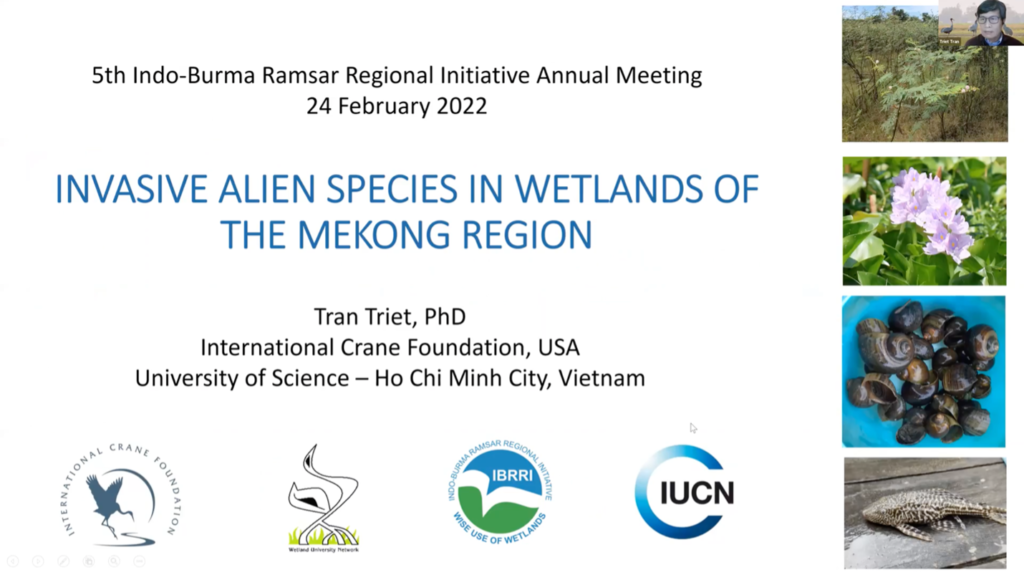
Summary of Recommendations from the Symposium on Invasive Alien Species ©Tran Triet/Mekong Wetland University Network
Following the informative presentations provided by the IBRRI Small Grant recipients, Dr. Triet Tran from Mekong Wetland University Network gave a presentation on Session 4 to suggest recommendations for the proper management of Invasive Alien Species (IAS). His presentation was based on the “Invasive Species in Wetlands of the Mekong Region Symposium”, which was held in 7-8 December 2021. The research was conducted in four countries (Cambodia, Lao PDR, Thailand, and Vietnam) and focused on four IAS: Mimosa pigra, Water hyacinth, Golden apple snail, and Suckermouth catfish. Dr. Tran stated that wetland ecosystems are vulnerable to IAS due to their severe impacts on biodiversity. For recommendations for IAS management, Dr. Tran suggested five different approaches. First, providing effective IAS control programs at wetland sites could support the early detection and eradication of IAS. Second, programs at national levels could provide thorough information on IAS for the implementation of comprehensive management activities. Third, IAS management could be facilitated by social and cultural campaigns conducted by local communities. Fourth, continuous research on regional IAS must proceeded, and fifth, cooperation between regional and international stakeholders should be encouraged by organizing relevant cooperative programs and research activities.
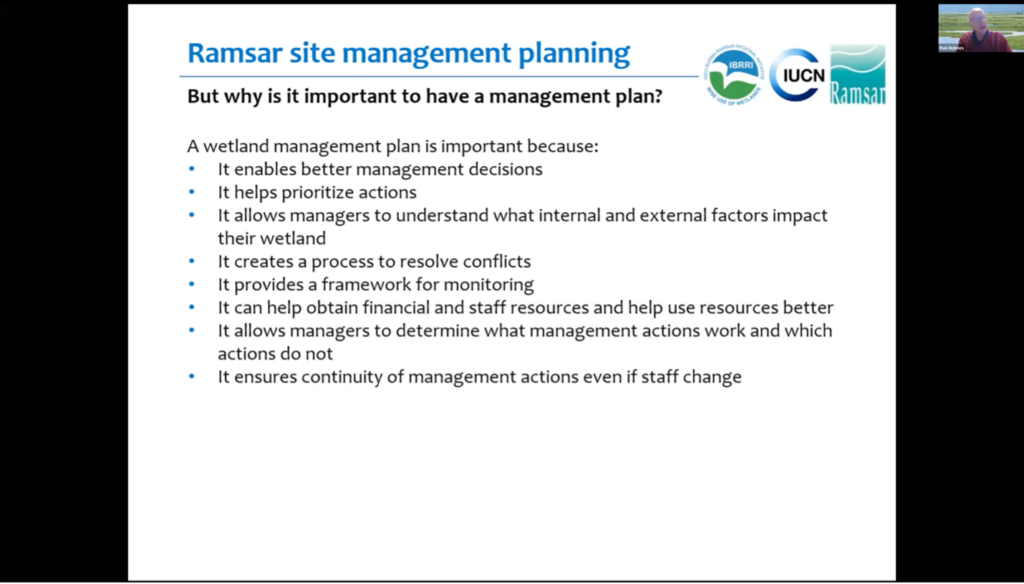
Development of Management Plans for two Ramsar Sites in the Indo-Burma Region ©Rob Mclnnes, International Rasmar Consultant
In Session 5, Mr. Rob Mclnnes, the Ramsar-related International Consultant gave a presentation on wetland management planning and its importance. Citing the Goal 2 of Ramsar 4th strategic Plan 2016-2024, Mr. Mclnnes emphasized the importance of effective conservation and management of existing Ramsar Site Network. Identifying that over 60% of the Ramsar Sites in the Indo-Burma Region currently lack proper management planning processes, He argued the importance of implementing management plans for Ramsar Sites and introduced two sites that is in progress of the management planning operation. These Two sites are Kaper Estuary at Laemson Marine National Park (also called as Ranong Rasmar Site), Thailand and Stung Treng, Cambodia. These sites currently either have no management plan or have been poorly managed due to limited capacities. Noting that there is a group of members developing the management plan for each site, Mr. Mclnnes shared four stages of Ramsar Site Management planning: description, evaluation, objectives/rationale, and action plan. The draft of management plans will be distributed to the IBRRI partners.
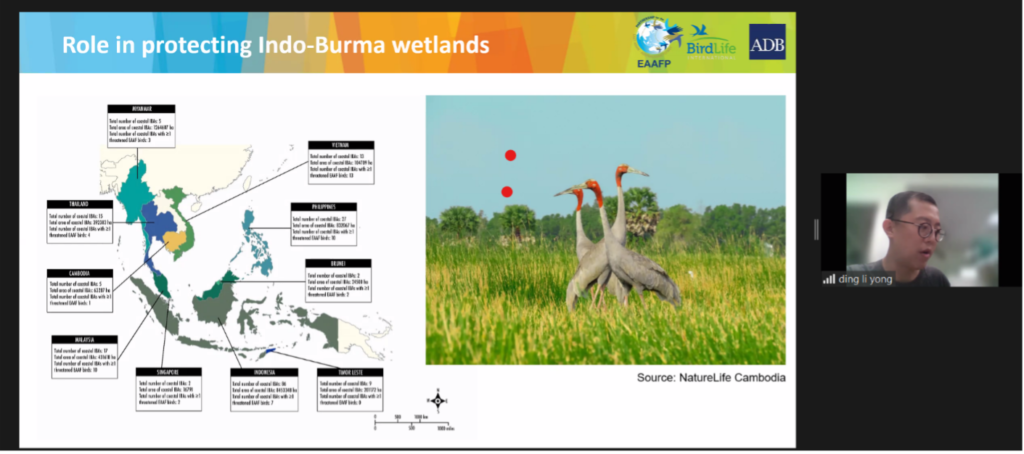
Introduction to the Regional Flyway Initiative: Investing in the East Asian-Australasian Flyway Partnership ©Ding Li Yong/BirdLife International
In the last session the EAAFP Secretariat and BirdLife International jointly presented the Regional Flyway Initiative (RFI), a long-term investment program to finance nature conservation and restore internationally important wetlands in the EAA Flyway for migratory waterbirds and local communities. Dr. Ding Li Yong, the Asia Policy and Advocacy Manager and Regional Flyways Coordinator of BirdLife International, presented the overview of the RFI and how its Technical Assistance (TA) project will proceed the prioritization of wetland sites for investments. Ms. Yoon Lee, the External Relations Manager at EAAFP Secretariat, gave a presentation on how the Initiative will build on and scale up the implementation of EAAFP Strategic Plan 2019-2028. She emphasized that the Initiative can bring key opportunities for the participating EAAFP Countries to meet the governments’ commitments to Multilateral Environmental Agreements such as Ramsar Convention, CBD, CMS, and UNFCCC ,while achieving their national development goals.
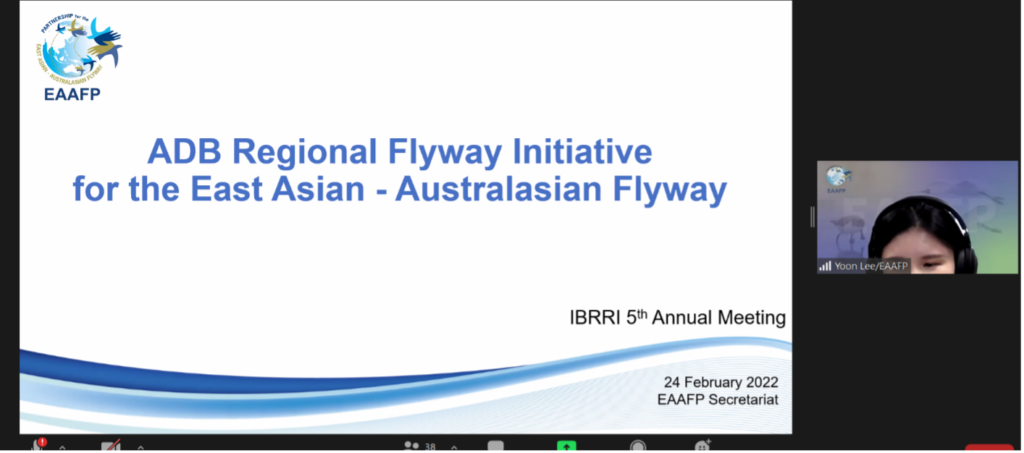
ADB Regional Flyway Initiative for the East Asian – Australasian Flyway ©Yoon Lee/EAAFP Secretariat
The IBBRI Secretariat concluded the meeting by expressing gratitude to all the presenters and participant for joining the meeting and answering to questions regarding the wetlands and initiatives.
Learn more:

